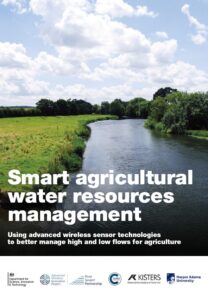Smart agricultural water resources management
We need ‘smarter’ agricultural water management
With growing competition for water resources across different sectors, coupled with escalating pressures of climate change and regulatory reforms, More efficient irrigation is now vital for agricultural sustainability, particularly in water-stressed catchments where irrigated agriculture underpins rural livelihoods.
Advanced wireless sensor technologies offer a means of managing high and low river flows that create challenges for irrigators.
This booklet describes a pilot study in the River Strine catchment area in Shropshire to assess challenges and values of implementing advanced wireless sensor technologies for monitoring local water resources: how data can help farmers pre-empt risks and reduce their vulnerability to high and low flows passing through their catchment.
Presentations at Symposium on
Advanced wireless sensors for agricultural water resources management
at Harper Adams University 11 Sept 2025
The current agricultural drought has further reinforced not only the critical importance of water for high-value irrigated production but also the sector’s vulnerability to supply shortages and the need to improve short and medium-term planning. With support from DSIT and Shropshire Council two flagship projects focused on how data from advanced wireless sensors can support catchment scale agricultural water resources monitoring and management and how they can also inform implementation of precision irrigation management in high value salad crop production.
This mini-symposium presented the key outcomes from these projects and discussed how the lessons learnt can benefit both farmers and stakeholders not only in the Shropshire region but also in other areas where similar challenges exist.
Welcome Dr Rich Blackwell, Technical Director, Water Resources West (WRW)
Introduction to DSIT Shropshire Council funded projects. Jerry Knox, Cranfield University
Session 1: Integrating agriculture into catchment scale water resources management
Challenges managing local water resources in the Strine catchment. Severn Trent speaker (tbc)
Role of wireless sensors to support agricultural water resources monitoring. Matthew Ellison (Kisters)
Where is water for peatland restoration going to come from? Ian Holman (Cranfield University) & Julia Casperd/Scott Kirby (HAU)
Modelling land and water interactions in the Strine catchment to assess urban, agricultural and environmental implications and trade-offs. Andrea Momblanch, Bob Grabowski and Azizullah Jahish (Cranfield)
Session 2: Implementing precision irrigation to reduce climate and water related risks
Managing irrigation under conditions of increased regulatory and drought risks – the role of local abstractor groups. Sarah Faulkner (Faulkner & Mayne Sustainable Agriculture Ltd)
To Come: Monitoring high & low flows: scalping floods for reservoir storage. Jerry Knox, Ian Holman and Jae Hun Shin (Cranfield University)
Using sensor data to model yield and water use in high value salad production. Niranjan Panigrahi (Cranfield University)
Development and application of IMIS – an Irrigation Management Information System. Francisco Puig and Juan Antonio Rodriguez Diaz (Universidad de Cordoba)
503 total views, 2 views today

